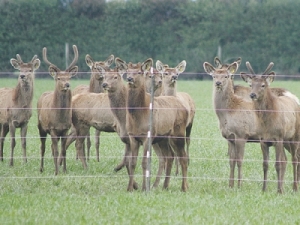Deer farmer targets poor performers, saves money
Management practices that aim to cull the poor performers rather than boost the best are a key to success for Canterbury deer farmer Stu Stokes.
 DINZ are promoting new cuts to chefs to increase returns from the whole deer carcass and to help keep venison on restaurant menus.
DINZ are promoting new cuts to chefs to increase returns from the whole deer carcass and to help keep venison on restaurant menus.
Venison exporters and Deer Industry NZ (DINZ) are promoting new cuts to chefs to increase returns from the whole deer carcass and to help keep venison on restaurant menus.
Venison production to April this year was down 20% on the same period last year, driven by herd rebuilding, with the hind kill down 25%. On 13 June the average stag venison schedule stood at $7.55 a kilogram, versus $6.67 a year before, an increase of 13%, despite a steady firming of the Kiwi against the US dollar and Euro in recent months.
DINZ Passion2Profit manager Innes Moffat says the usual spring peak in prices to farmers will this year be the highest it has been in four or five seasons, even if further currency appreciation knocks the top off.
"Like all export industries we are concerned about the apparent inability of the Reserve Bank to ease the pressure on the Kiwi dollar."
He says frozen stocks in the European market were cleared in 2015, stimulating the higher venison prices received last year. This year exporters are managing their customers' requirements, by warning that shipments will be down on previous years.
A big part of the challenge, says Moffat, is the widening price gap between venison and other premium proteins. Meanwhile, South African ostrich – a European game season substitute for venison – has regained market access.
While there is clearly a limit to what customers are willing to pay, culinary fashion may help.
DINZ consultant chef Graham Brown says there is a growing trend for chefs to incorporate cuts from the shoulder, neck and brisket – even offals like hearts, livers, sweetbreads and tongues – into their menus.
"Braised and slow-cooked meats are very fashionable. They provide chefs with a challenge and a point of difference.
"Also, as prices escalate for the premium cuts, chefs will sometimes provide an item which features, say, a tender pink medallion and something slow-cooked, like pulled brisket. In this way they can reduce the average cost of the protein on the plate, while giving the diner a great eating experience."
He says each exporter offers its customers a different range of cuts, but overall there has been a steady increase in further processing.
"Many people in the industry will remember when venison was being exported as primal cuts. Now we have a whole raft of de-silverskinned shoulder cuts, individual steaks, tri-tips, bolar roasts, crosscut for braising, spare ribs, petit filets, fore shanks, cheeks and human food grade offals. The list goes on ... value has been added across the whole carcass."
With supply constrained through the herd rebuilding phase over the next few years Moffat says the venison marketing companies will continue to have active promotional campaigns underway to promote new items to new and existing customers.
"While DINZ has reduced its focus on the traditional German food service market it continues to support company initiatives to reduce the reliance on the spring peak in demand, by growing sales in non-seasonal markets and in new markets promoting retail or value-added items.
"It may sound counter-intuitive to be promoting while supply is short, but we need to help exporters keep NZ venison on menus and top of mind for the long-term when production does begin to increase.
"For their part, exporters will be offering their customers the full range of cuts they have on offer at price points that will work for chefs and new consumers, especially those who are keen to innovate.
"There will inevitably be some loss of market share to other proteins, but it is critical that we continue to supply those customers who are sold on the merits of NZ venison."
The Coalition Government will need the support of at least one opposition party to ratify the free trade deal with India.
Primary sector leaders have welcomed the announcement of a Free Trade Agreement between India and New Zealand.
At Pāmu’s Kepler Farm in Manapouri, mating has wrapped up at the across-breed Beef Progeny Test.
More than 150 people turned up at Parliament recently to celebrate the 20th anniversary of Horticulture New Zealand (HortNZ).
Biosecurity New Zealand says Kiwis should continue to keep an eye out for yellow-legged hornets (Vespa velutina) over the holiday season.
Fonterra has slashed another 50c off its milk price forecast as global milk flows shows no sign of easing.

OPINION: The release of the Natural Environment Bill and Planning Bill to replace the Resource Management Act is a red-letter day…
OPINION: Federated Farmers has launched a new campaign, swapping ‘The Twelve Days of Christmas’ for ‘The Twelve Pests of Christmas’ to…